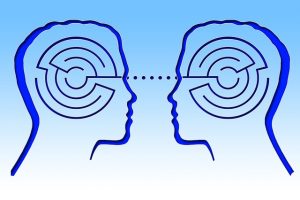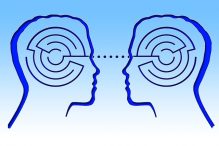 We understand best those who communicate as we do.
We understand best those who communicate as we do.
What does “communicating like me” mean? What are the variables in communication? Consider these factors: language, accent, volume, vocabulary and expressions, grammar, body language, level of formality, cultural references, passive vs aggressive communication patterns, auditory vs visual communication preferences, etc. It’s a wonder we can comprehend each other at all!
When others communicate differently than we do, we tend to make assumptions and judgments. This is where clear communication can get sidetracked. And this is where paying attention to our attitude and behaviour comes in.
HOW ATTITUDES AFFECT COMPREHENSION
Let’s explore a few aspects of attitude that can negatively affect our comprehension.
Assumptions, judgments and mind reads
“I went to a resort and was the only one from out-of-town. Everybody in the restaurant was white and looking at me thinking; “This guy is not from our town.” I could see it. Everybody was staring at me.” – Presentation participant
I use this quote, not because I think it is incorrect – we all know this reaction – but rather as an example of a “mind-read”. While this perception may be completely correct and true, there is no way for this person to know what the people in the restaurant are really thinking. It is a projection. Clearly the speaker is a person of colour and conscious of this difference. Experience and belief, possibly combined with some self-consciousness and maybe insecurity, lead to this “mind-read”.
We all do this. As a teacher, if I see a student looking at me with a furrowed brow, I tend to think they are judging or disagreeing with me. It could simply be that they have a headache or poor vision. But because I felt judged by my father who looked at me in that way, I feel certain my “mind-read” is correct.
A mind-read is just one example of an assumption and a judgment which may or may not be correct. If it is incorrect, any communication that follows is misleading and likely ineffective.
Stereotypes and an us/them mentality
Another aspect of attitude is stereotyping which leads to an us/them perspective. We all tend to stereotype. Here’s an example:
“A woman came for a communication assessment since “people always interrupted her and it must be my accent.” She talked non-stop for about 40 minutes and I had to interrupt her to start the assessment. She completely stopped talking. I asked her what the matter was and she said: “You people always interrupt us.” – Language trainer
While this testimonial clearly indicates a lack of self-awareness, it illustrates an us/them mentality. This can only exist with stereotyping. In contrast to generalizing, which we all do to make decisions, stereotyping is rigid and absolute rather than flexible, highlighting what are rightly or wrongly considered to be common tendencies. It doesn’t allow for individual differences and it inhibits self-reflection and true observation.
Learning to identify our stereotypes and put them aside can allow us to pay attention to our own thought processes, to pay attention to details, to listen better and consider how our own experience and identity may not be allowing us to understand.
HOW BEHAVIOURS AFFECT COMPREHENSION
This is an immense topic so I will only address a few areas related to communicative behaviours.
Vocabulary, idioms and expressions
I remember when I first heard the word “sick” being used in the completely opposite way I had grown up to interpret it – now meaning amazing, fantastic, wonderful! The vocabulary we choose, the meaning we attribute, our choice of expressions and idioms, our usage of phrasal verbs, etc. can all lead to either communicating clearly or unclearly.
Most native speakers use phrasal verbs (turn on, turn into, turn around, turn off) without thinking. They seem simple to us if it is our native language. But there are thousands, many with double meanings (turn off the light vs being turned off by someone, for example). This is also true of idioms – sleep on it, cut someone some slack, back in a wink – they are endless. And both phrasal verbs and idioms often have no meaning that can be interpreted through deduction unless you observe their usage over time or have a similar expression in another language you know.
Cultural references
 So much humour is based on cultural references. For example, understanding this joke means knowing the 1967 song by Buffalo Springfield.
So much humour is based on cultural references. For example, understanding this joke means knowing the 1967 song by Buffalo Springfield.
A cultural reference could simply be mentioning “residential schools”. In Canada, we would generally interpret this to be “the forced relocation of indigenous children into repressive educational institutions”, while in another context it would probably mean “boarding schools”.
As with vocabulary usage, our tendency is generally to use cultural references without being aware that other people may not understand them or even that we are using them.
Speed and enunciation
In English, we tend to speak more slowly, with fewer syllables per minute, than many other languages. Speaking quickly with poor enunciation makes for poor clarity and weak comprehension for both native and non-native speakers.
HOW WE CAN FACILITATE COMPREHENSION
Given so many aspects that can make communication difficult, what can all of us do to facilitate it? Here are a few ideas:
- Mix with people from other cultures – become familiar with different accents and different cultural behaviours and practices. This may be uncomfortable, but change is uncomfortable at first. Overtime, this will only enrich us all.
- Be careful with the pace of your speech and pay attention to enunciation. This is especially true when both native and non-native speakers are communicating. Speaking more slowly allows for time to process any input that is confusing the listener, including accent, vocabulary, grammar, references, etc.
- Develop awareness of your own choice of language and the cultural references you use. This awareness takes time and practice. Note that it does not mean you can’t use such vocabulary and examples (see the following point), but it does require self-awareness and practice.
- If you think a person you are speaking with may not understand, ask if they are familiar with the word, expression or reference. If they aren’t, take the time to explain or use a synonym. As a native speaker, while it is easy to get caught up in a fast-paced conversation with other native speakers, taking time to ask and explain leads to inclusiveness and, consequently, better relations.
- Question your perceptions and the roots of your judgments. Become aware that you are making a judgment or an assumption and whether you are projecting a mind-read. This also takes self-awareness and can develop over time.
- Practice nonjudgment. I was once asked to practice “benevolent acceptance” in order to be open. Later, when things become clear, you can make your judgments.
- Choose an interpretation that leads to connection rather than disconnection. Beliefs are simply thoughts that you repeatedly think over time. You can change them if you choose to.

